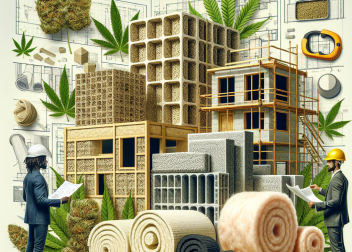The History Of Cannabis & THC
Introduction
The history of Cannabis and THC dates back thousands of years and spans across various cultures and civilizations. Cannabis, also known as marijuana, has been used for medicinal, spiritual, and recreational purposes throughout history. THC, or delta-9-tetrahydrocannabinol, is the primary psychoactive compound found in cannabis that produces the characteristic “high” effect. Understanding the history of Cannabis and THC provides valuable insights into their cultural significance and evolving legal status.
The Ancient Origins of Cannabis and Its Historical Uses
The history of Cannabis and THC is a fascinating journey that dates back thousands of years. From its ancient origins to its historical uses, cannabis has played a significant role in various cultures around the world. Let’s delve into the rich history of this plant and explore how it has been utilized throughout time.
Cannabis, also known as marijuana, has been cultivated for its medicinal and psychoactive properties for centuries. Its origins can be traced back to ancient civilizations in Asia, where it was first used for its fibers to make textiles and ropes. The Chinese were among the first to discover the medicinal benefits of cannabis, using it to treat various ailments such as pain, inflammation, and malaria.
As time went on, cannabis spread to other parts of the world, including the Middle East and Africa. In ancient Egypt, cannabis was highly regarded and used for both medicinal and religious purposes. The Egyptians believed that cannabis had healing properties and used it to treat conditions like glaucoma and hemorrhoids.
In India, cannabis played a significant role in religious and spiritual practices. The plant was considered sacred and was associated with the Hindu god Shiva. Cannabis, known as “ganja” in India, was used during religious ceremonies and meditation to induce a state of relaxation and heightened awareness.
Moving forward in history, cannabis made its way to Europe and the Americas through trade routes. In Europe, cannabis was primarily used for its fibers to make textiles and paper. However, it wasn’t until the 19th century that cannabis started gaining attention for its medicinal properties once again.
During this time, scientists began isolating and studying the active compounds in cannabis, leading to the discovery of tetrahydrocannabinol (THC). THC is the psychoactive compound responsible for the “high” associated with cannabis use. Its discovery paved the way for further research into the effects and potential medical applications of cannabis.
In the early 20th century, cannabis started facing increasing scrutiny and legal restrictions due to concerns about its potential for abuse. The United States, in particular, implemented strict regulations on cannabis, culminating in the prohibition of its use and cultivation in 1937.
However, in recent years, there has been a shift in attitudes towards cannabis, with many countries and states legalizing its use for medicinal and recreational purposes. This change has sparked renewed interest in the potential therapeutic benefits of cannabis and its derivatives, including THC.
Today, cannabis and THC are being studied for their potential in treating a wide range of conditions, including chronic pain, epilepsy, multiple sclerosis, and even cancer. Research has shown that THC can help alleviate pain, reduce inflammation, and stimulate appetite, making it a valuable tool in the medical field.
As we continue to explore the history of Cannabis and THC, it becomes clear that this plant has a long and storied past. From its ancient origins in Asia to its modern-day uses, cannabis has evolved and adapted to meet the needs of different cultures and societies. As more research is conducted, we can expect to uncover even more about the potential benefits and applications of cannabis and THC in the future.
Cannabis in Ancient Civilizations: From Egypt to China
Cannabis, also known as marijuana, has a long and fascinating history that dates back thousands of years. From its origins in ancient civilizations to its modern-day uses, this plant has played a significant role in various cultures around the world. In this article, we will explore the history of Cannabis and its active compound, THC, focusing on its presence in ancient civilizations such as Egypt and China.
Ancient Egypt, known for its rich history and cultural achievements, was one of the first civilizations to document the use of cannabis. The ancient Egyptians used cannabis for both medicinal and religious purposes. They believed that the plant had healing properties and used it to treat various ailments, including inflammation and pain. Additionally, cannabis was often used in religious ceremonies and rituals, where it was believed to connect individuals with the divine.
Moving eastward, ancient China also has a long-standing relationship with cannabis. The Chinese were among the first to discover the psychoactive properties of cannabis and began using it for recreational purposes. The plant was often consumed in the form of tea or smoked for its euphoric effects. However, cannabis in China had a broader range of uses beyond recreation. It was also used as a medicinal herb, believed to have therapeutic properties for treating conditions such as malaria, constipation, and rheumatism.
In both ancient Egypt and China, cannabis played a significant role in their respective cultures. It was not only used for its medicinal properties but also held spiritual and religious significance. The plant was seen as a bridge between the physical and spiritual realms, allowing individuals to connect with higher powers and gain insight into the mysteries of the universe.
As time went on, the use of cannabis spread to other ancient civilizations, such as India and Persia. In India, cannabis was mentioned in ancient texts known as the Vedas, where it was referred to as “sacred grass” and considered a gift from the gods. It was used in religious rituals and ceremonies, as well as for its medicinal properties. Similarly, in Persia, cannabis was used for both recreational and medicinal purposes, with references to its use found in ancient Persian texts.
The use of cannabis in ancient civilizations was not limited to its psychoactive effects. The plant’s fibers were also utilized for various practical purposes. For example, in ancient China, cannabis fibers were used to make textiles, ropes, and paper. In Egypt, cannabis was used to make ropes and sails for boats, as well as for medicinal ointments and oils.
In conclusion, cannabis has a long and storied history that stretches back thousands of years. From its origins in ancient civilizations such as Egypt and China, this plant has been used for medicinal, recreational, and practical purposes. Its psychoactive compound, THC, has played a significant role in the cultural and spiritual practices of these civilizations. As we continue to explore the history of Cannabis and THC, we will delve into their presence in more recent times and their evolving uses in modern society.
Cannabis Prohibition and the War on Drugs: A Historical Perspective
Cannabis Prohibition and the War on Drugs: A Historical Perspective
Cannabis, also known as marijuana, has a long and complex history that spans thousands of years. From its early use in ancient civilizations to its controversial status in modern times, cannabis has been a subject of fascination and debate. One significant chapter in this history is the prohibition of cannabis and the subsequent war on drugs.
The prohibition of cannabis can be traced back to the early 20th century when various countries began to enact laws restricting its use. In the United States, the first federal law criminalizing cannabis was the Marihuana Tax Act of 1937. This act imposed heavy taxes and regulations on the cultivation, sale, and possession of cannabis, effectively making it illegal.
The motivations behind cannabis prohibition were multifaceted. Some argued that cannabis was a dangerous drug that posed significant health risks, while others believed it was associated with criminal behavior and moral decay. Additionally, racial and cultural biases played a role in shaping public opinion towards cannabis. The fear of Mexican immigrants and African Americans, who were often associated with cannabis use, fueled the push for prohibition.
The prohibition of cannabis gained further momentum in the 1960s and 1970s with the rise of the counterculture movement and the Vietnam War. Cannabis became a symbol of rebellion and anti-establishment sentiment, leading to increased usage among young people. This surge in popularity alarmed authorities, who saw cannabis as a threat to social order and national security.
In response to the growing use of cannabis, the United States government declared a “war on drugs” in the 1970s. This war aimed to eradicate drug use and trafficking through aggressive law enforcement and punitive measures. Cannabis was classified as a Schedule I controlled substance, alongside drugs like heroin and LSD, indicating that it had no accepted medical use and a high potential for abuse.
The war on drugs had far-reaching consequences, particularly for communities of color. Law enforcement disproportionately targeted minority communities, leading to a significant increase in arrests and incarceration rates for non-violent drug offenses. This approach not only failed to curb drug use but also perpetuated systemic inequalities and social injustices.
In recent years, there has been a growing recognition of the failures of cannabis prohibition and the war on drugs. Many states in the United States have legalized cannabis for medical and/or recreational use, acknowledging its potential therapeutic benefits and economic opportunities. Moreover, public opinion has shifted, with a majority of Americans now supporting the legalization of cannabis.
The historical perspective on cannabis prohibition and the war on drugs highlights the complexities and contradictions surrounding drug policy. It reveals the influence of cultural, racial, and political factors in shaping public opinion and legislation. As society continues to grapple with drug policy, it is crucial to consider evidence-based approaches that prioritize harm reduction, social justice, and public health.
In conclusion, the prohibition of cannabis and the subsequent war on drugs have had a profound impact on society. The historical context sheds light on the motivations behind cannabis prohibition and the consequences of aggressive drug enforcement. As attitudes towards cannabis evolve, it is essential to learn from the past and strive for more equitable and effective drug policies.
The Modern Era: Cannabis Legalization and its Impact on Society
The Modern Era: Cannabis Legalization and its Impact on Society
In recent years, there has been a significant shift in the perception and legality of cannabis. What was once considered a taboo substance is now being embraced by many as a natural remedy and recreational substance. This change in attitude towards cannabis can be attributed to the growing body of research highlighting its potential benefits and the push for legalization.
The movement towards cannabis legalization gained momentum in the late 20th century, with several states in the United States leading the way. California became the first state to legalize medical marijuana in 1996, followed by many others in subsequent years. This marked a turning point in the history of Cannabis, as it opened the door for further exploration of its medicinal properties.
As more states began to legalize medical marijuana, the public’s perception of cannabis started to shift. People began to see it as a legitimate form of medicine that could alleviate symptoms of various conditions, such as chronic pain, epilepsy, and even cancer. This newfound acceptance of cannabis as a therapeutic substance paved the way for further research into its potential benefits.
In addition to medical marijuana, the push for recreational cannabis legalization also gained traction. In 2012, Colorado and Washington became the first states to legalize recreational marijuana, setting a precedent for others to follow. This move was driven by the belief that cannabis should be treated similarly to alcohol, with regulations in place to ensure responsible use.
The legalization of recreational cannabis has had a profound impact on society. It has created a new industry, generating jobs and tax revenue for states that have embraced it. This has also led to a decrease in the black market for cannabis, as consumers now have access to legal and regulated products. Furthermore, it has sparked a cultural shift, with cannabis becoming more mainstream and accepted in everyday life.
However, the legalization of cannabis is not without its challenges. One of the main concerns is the potential for increased use among young people. Critics argue that making cannabis more accessible could lead to higher rates of addiction and impaired cognitive development. To address these concerns, states that have legalized cannabis have implemented strict regulations, such as age restrictions and limits on THC content.
Another issue that has emerged is the lack of standardized testing and quality control for cannabis products. With the industry booming, there is a need for consistent and reliable testing methods to ensure that consumers are getting safe and accurately labeled products. Efforts are being made to establish standards and regulations to address this issue and protect consumers.
Despite these challenges, the legalization of cannabis has undeniably had a positive impact on society. It has provided relief for countless individuals suffering from chronic pain and debilitating conditions. It has also created economic opportunities and contributed to the overall well-being of communities.
As we move forward, it is crucial to continue researching and understanding the potential benefits and risks of cannabis use. By doing so, we can ensure that legalization is accompanied by responsible use and proper regulations. The history of Cannabis has come a long way, and with continued education and open-mindedness, its potential to improve lives will only continue to grow.
Q&A
1. When was cannabis first used by humans?
Cannabis has been used by humans for thousands of years, with evidence of its cultivation dating back to around 4000 BCE.
2. Where did cannabis originate?
Cannabis is believed to have originated in Central Asia, specifically in the region that includes modern-day Mongolia and southern Siberia.
3. When was THC discovered?
THC, the psychoactive compound in cannabis, was first isolated and identified in 1964 by Israeli chemist Dr. Raphael Mechoulam.
4. How has cannabis been used throughout history?
Throughout history, cannabis has been used for various purposes, including medicinal, spiritual, and recreational use. It has been used in traditional medicine, religious ceremonies, and as a source of fiber for textiles and paper.
Conclusion
In conclusion, the history of Cannabis and THC is a complex and multifaceted one. Cannabis has been used for various purposes throughout history, from its early cultivation for fiber and medicine to its recreational and medicinal use in modern times. The discovery and isolation of THC in the 1960s played a significant role in understanding the psychoactive effects of cannabis and its potential therapeutic applications. Despite its controversial status in many parts of the world, ongoing research continues to shed light on the potential benefits and risks associated with cannabis and THC, shaping the future of its use and regulation.
![]()



